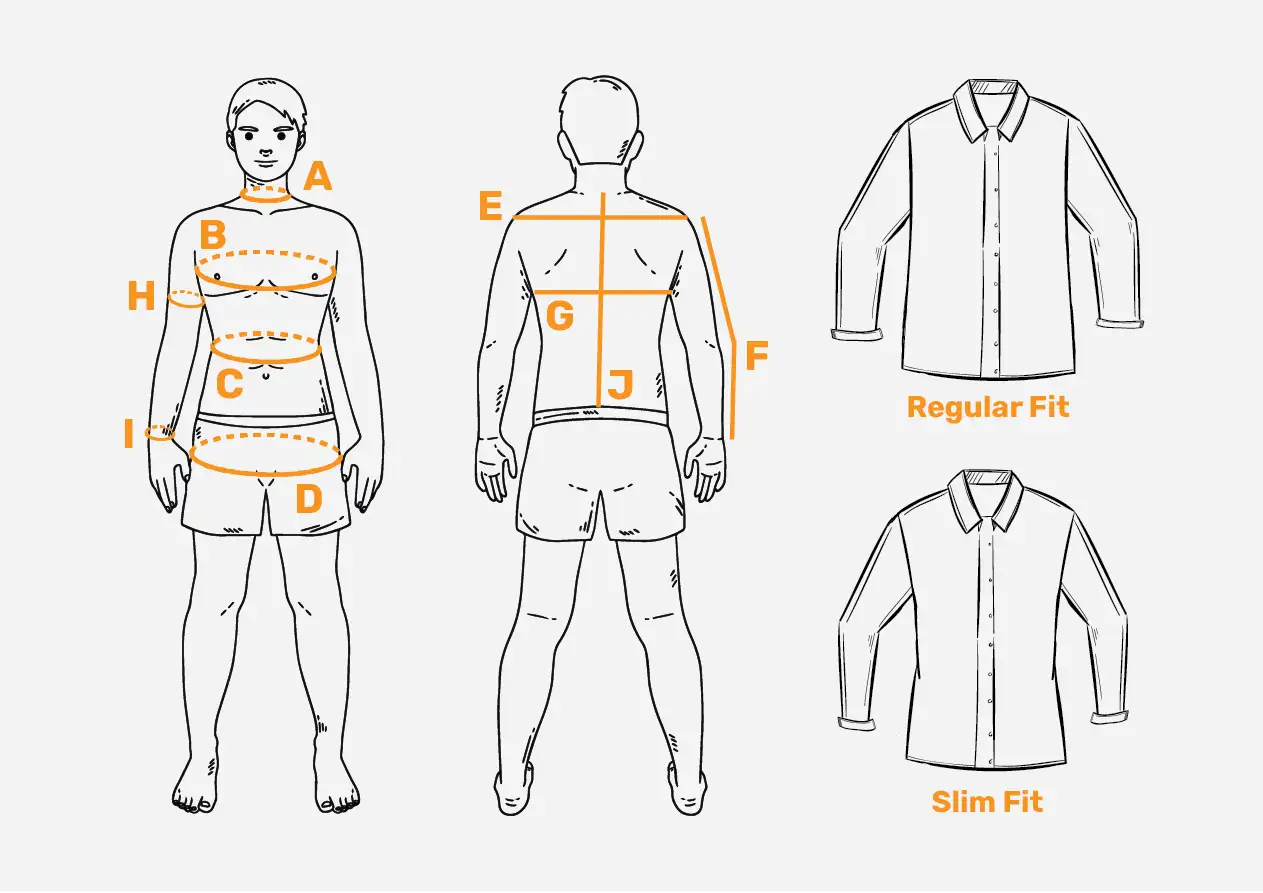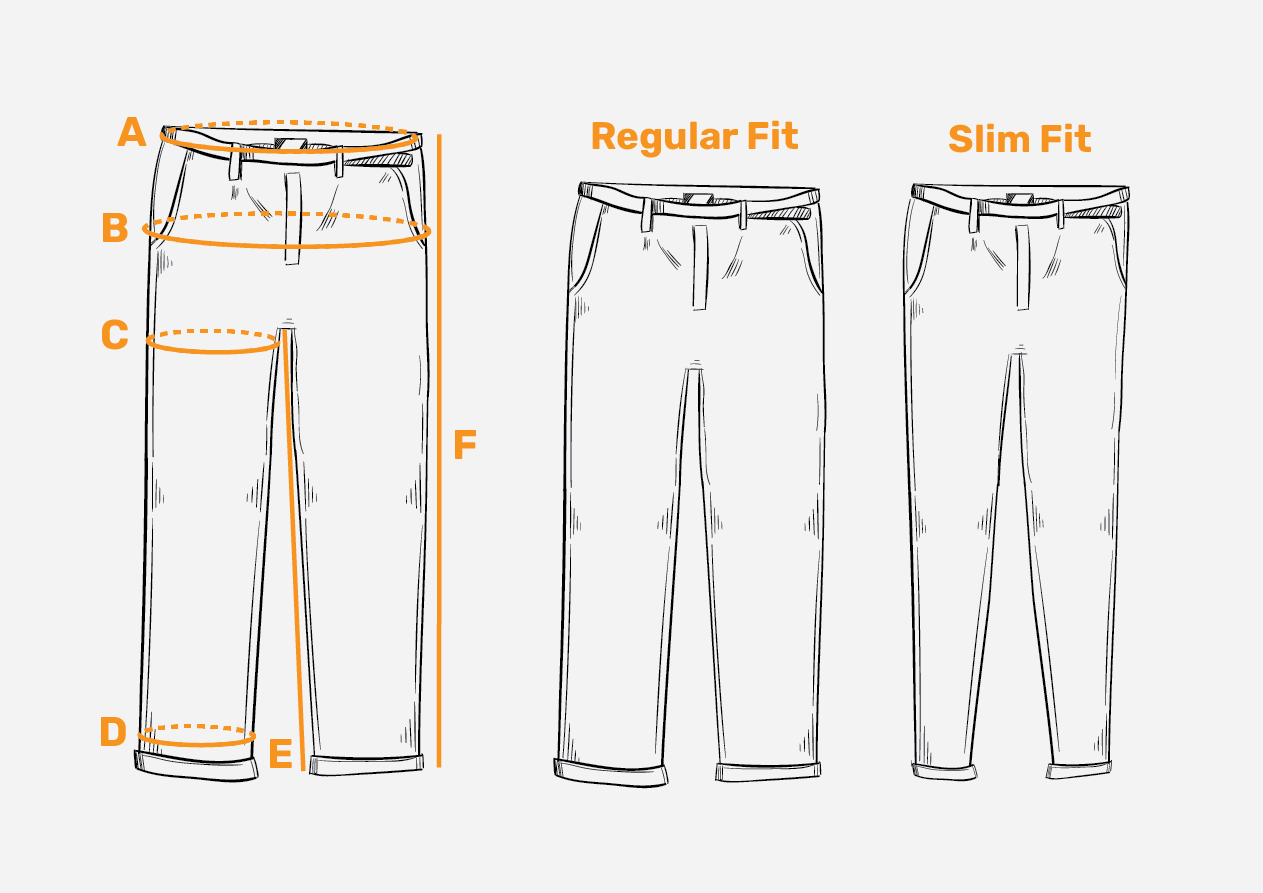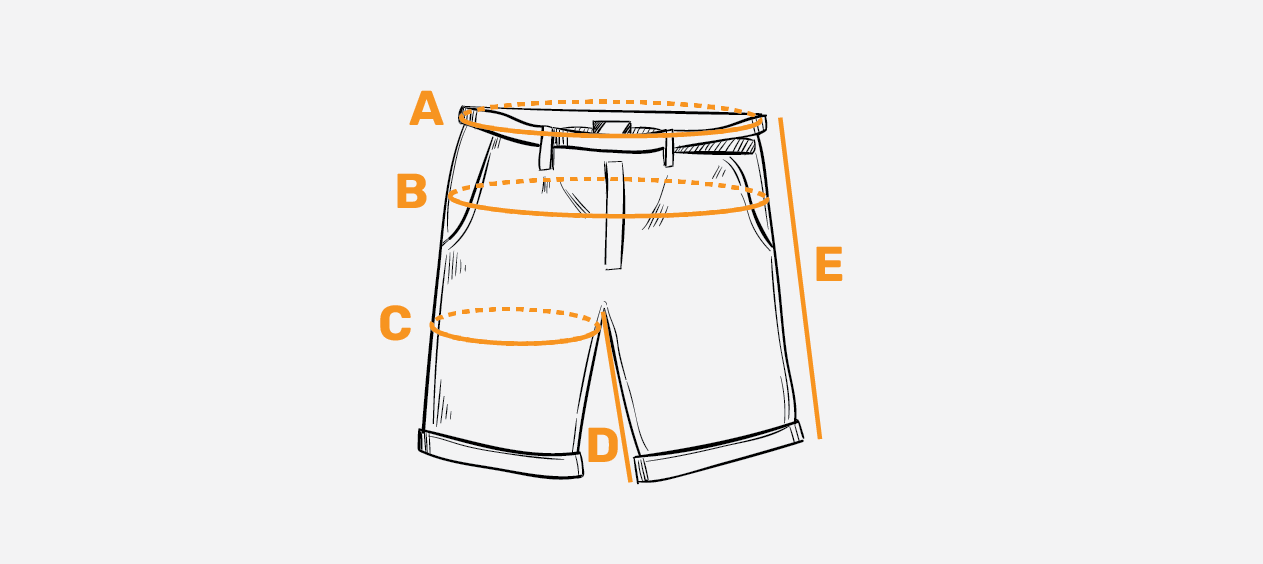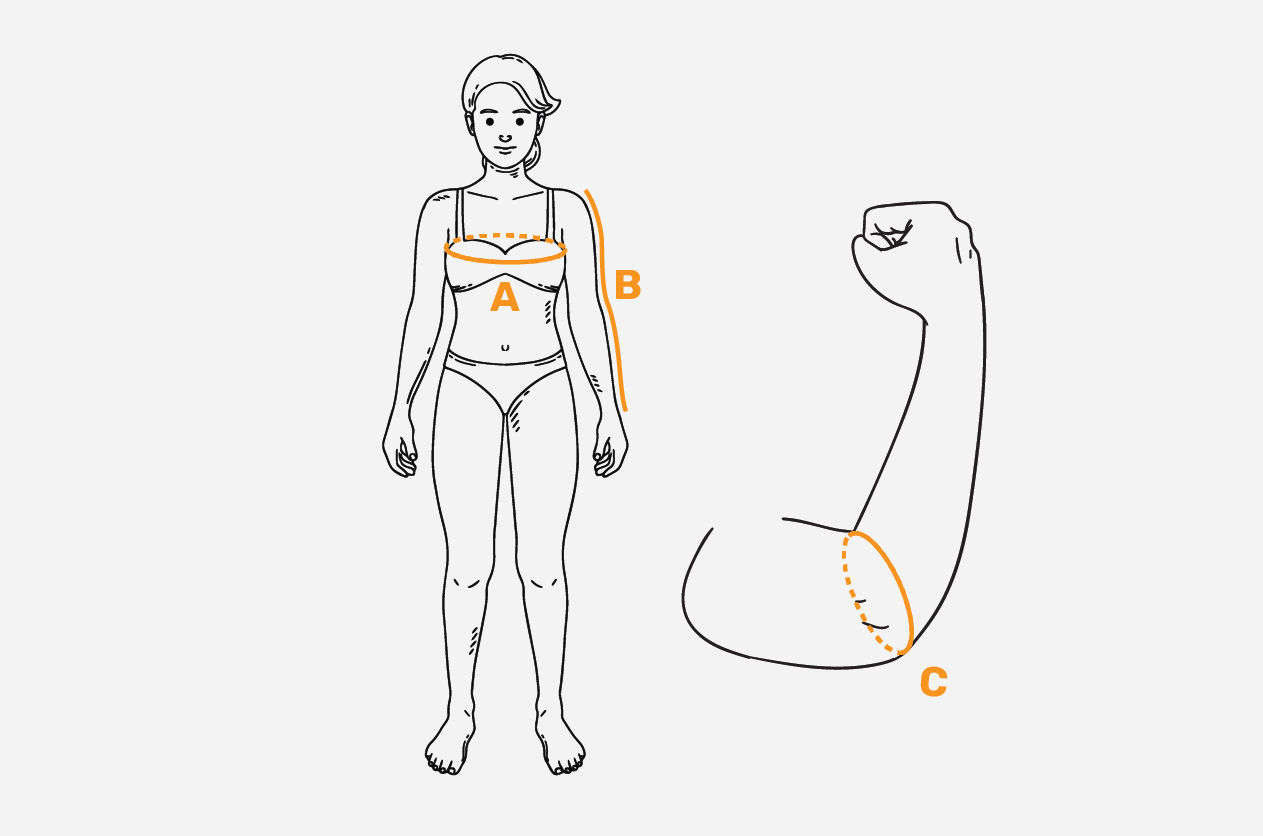Taking Measurements and Size Charts
How to Measure Yourself Correctly
The best way to get perfectly fitting, custom-made clothing is to go to a tailor and have them measure you. A meticulous tailor will probably call you in for a fitting before the garment is finished to correct any minor discrepancies. When shopping at an online tailor, it is important to provide as accurate body measurements as possible. Since the tailor can’t see you, he or she will only be relying on numbers. Our guide will help you get the right measurements.
How to prepare for the measurement
Prepare a tape measure or a piece of string or ribbon, which you will then measure with a ruler. For greater accuracy, we recommend asking a loved one to help you with the measurement.
Measure directly on the body, only over underwear. When measuring, stand upright but in a natural, relaxed position. Let your arms hang freely along your body. Always keep the tape measure horizontal. It should not be constricting or hanging too loosely. Take a deep breath and make sure that your body is not significantly restricted in movement and that your clothing is not too tight. Do not try to pull in your stomach. Your waist circumference may be different in the morning before breakfast or in the evening. It is better to allow for some space.
Tailored shirts
How to choose a Regular Fit or Slim Fit
The difference between the Regular Fit (classic) and Slim Fit (narrowed) cut lies in the degree of waistline, narrowing of the armholes and narrowing of the shirt sleeves. The classic Regular Fit shirt is almost straight in the body. The Slim Fit shirt is narrowed at the waist compared to the chest and waist. Two vertical darts on the back emphasize the slimness.

A/ Neck circumference
Place a tape measure around your neck, roughly at the level of your collarbone, or where you would normally wear a shirt collar. Don’t apply any pressure. Look straight ahead, don’t lower your chin.
B/ Chest circumference
Stand up straight and let your arms hang freely by your sides. Pull your shoulders back. Don’t try to arch your chest or tighten your back muscles. Place the tape measure under your armpits, over your nipples in front, and over your shoulder blades at the back, over the highest point of your breasts. Make sure the tape measure is horizontal – standing up in front of a mirror will help.
C/ Waist circumference
For most people, the waist is the narrowest point, but this may not be the case for everyone. Try putting your hands around your waist and leaning from side to side. Your natural waist is where your body bends. It is the space between the top of your hip bone and your last rib. Stand up straight, breathe normally – don’t puff up or pull your stomach in. Wrap the tape measure loosely, don’t pull it tight. For obese people, measure around the widest part of your waist, usually around your belly button.
D/ Hip circumference
People usually measure their hips at the hipbones, but this is not accurate. Stand with your feet together. Measure horizontally across the widest part of your seat – try to find the largest circumference around your buttocks. In most cases, the measurement will be close to the circumference of your chest.
E/ Shoulders
Measure across your back, running the tape measure from one shoulder to the other.
F/ Arm length
Measure with your arm slightly bent. Start at the top of your shoulder where you can feel your shoulder bone. This will be where your shirt sleeve seam is. Continue down your arm to the base of your thumb.
G/ Back width
Stand upright with your arms at your sides. Measure at the height where your arms touch your torso.
H/ Biceps
Measure across the widest part of your upper arm.
I/ Wrist
Place the tape measure tightly around your wrist, but not so that it cuts into your hand.
J/ Shirt length
Stand upright with your arms at your sides. Measure from the first cervical vertebra to where you expect the bottom of your shirt to be.
Tailored Trousers
How to choose a Regular Fit or Slim Fit
Regular Fit is a classic trouser cut with a standard waist and straight legs. Slim Fit is a narrower cut with a standard waist and legs that gradually taper from mid-thigh.

A/ Waist circumference
For most people, the waist is the narrowest part, but not everyone is. Try putting your hands around your waist and leaning from side to side. Your natural waist is where your body bends. It’s between the top of your hip bone and your last rib – usually where you want your trousers to end. Stand up straight, breathe normally – don’t puff out or pull your stomach in. Wrap the tape measure loosely, don’t pull it tight. For obese people, measure at the widest part of your waist, usually at your belly button. If you’re wearing trousers, measure just above your belt.
B/ Hip circumference
People usually measure their hips at the hipbones, but this is not accurate. Stand with your feet together. Measure horizontally across the widest part of your seat. Try to find the largest circumference around your buttocks. Now try sitting down with the tape measure around your buttocks and standing up again. Does it fit, is it constricting, or are you holding the tape measure incorrectly? It often happens that trousers fit perfectly when you are standing, but when you sit down they are too tight, which is due to poor measurement. In most cases, the measurement will be close to the circumference of your chest.
C/ Thigh circumference
Measure horizontally around the widest part of your thigh at crotch height – usually just past mid-thigh – closer to your torso.
D/ Ankle circumference
Measure the circumference of your shin at or just above the ankle.
E/ Inner leg length
Measure from the crotch along the inner thigh to the heel.
F/ Side length of pants
Measure from your waist to your heel. For a more accurate measurement, you can tie a ribbon around your waist and measure from its bottom edge.
Shorts

A/ Waist circumference
For most people, the waist is the narrowest part, but not everyone is. Try putting your hands around your waist and leaning from side to side. Your natural waist is where your body bends. It’s between the top of your hip bone and your last rib – usually where you want your trousers to end. Stand up straight, breathe normally – don’t puff out or pull your stomach in. Wrap the tape measure loosely, don’t pull it tight. For obese people, measure at the widest part of your waist, usually at your belly button. If you’re wearing trousers, measure just above your belt.
B/ Hip circumference
People usually measure their hips at the hipbones, but this is not accurate. Stand with your feet together. Measure horizontally across the widest part of your seat. Try to find the largest circumference around your buttocks. Now try sitting down with the tape measure around your buttocks and standing up again. Does it fit, is it constricting, or are you holding the tape measure incorrectly? It often happens that trousers fit perfectly when you are standing, but when you sit down they are too tight, which is due to poor measurement. In most cases, the measurement will be close to the circumference of your chest.
C/ Thigh circumference
Measure horizontally around the widest part of your thigh at crotch height – usually just past mid-thigh – closer to your torso.
D/Inner leg length
Measure from the crotch along the inner thigh to where you want the shorts to end. The classic length of shorts reaches the bend of the knee joint (mid-knee).
E/ Side length of shorts
Measure the length from your waist to where you want the shorts to end. The classic length of shorts reaches the bend of the knee joint (midway down the knee).
Women’s gown

A/ Chest circumference
Stand up straight and let your arms hang freely by your sides. Pull your shoulders back. Don’t try to arch your chest or tighten your back muscles. Place the tape measure under your armpits, over your nipples in front, and over your shoulder blades at the back, over the highest point of your breasts. Make sure the tape measure is horizontal – standing up in front of a mirror will help.
B/ Arm length
Measure with your arm slightly bent. Start at the top of your shoulder where you can feel your shoulder bone. This will be where your shirt sleeve seam is. Continue down your arm to the base of your thumb.
C/ Elbow circumference
Bend your arm at the elbow about 45 degrees and measure across the elbow joint.
Size charts
If you decide to buy standard-sized clothing from our online tailoring shop, check our size charts to make sure the measurements meet your expectations. When ordering, remember that the clothing measurements must always be larger than your body measurements.
If you want to get original, custom-made clothing, we will be happy to create it for you exactly according to your body measurements, which you fill in when ordering.
Standard trouser sizes
The standard trouser size is determined by the waist circumference and the inseam length.
Size chart – trousers
| Standard size | S | M | L | XL | XXL | ||||||
| Waist circumference | inches | W 28 | W 30 | W 32 | W 33 | W 34 | W 36 | W 38 | W 40 | W 42 | W 44 |
| cm | 71.5 | 76.5 | 81.5 | 84 | 86.5 | 91.5 | 96.5 | 102 | 107 | 112 | |
| Standard size | S | M | L | XL | |
| Inseam length | inches | L 30 | L 32 | L 34 | L 36 |
| cm | 76 | 81 | 86.5 | 91.5 | |
Standard shirt sizes (cm)
Regular Fit
| S | M | L | XL | XXL | 3XL | |
| collar circumference | 38 | 39.50 | 41.50 | 43.50 | 45.50 | 47.50 |
| chest circumference | 110 | 116 | 124 | 132 | 140 | 150 |
| waist circumference | 100 | 108 | 116 | 126 | 134 | 146 |
| back width | 44 | 46 | 49 | 53 | 56 | 58 |
| shirt length | 76.50 | 78.50 | 81 | 83.50 | 84.50 | 85.50 |
| sleeve length | 66 | 66 | 66 | 66 | 66 | 66 |
| short sleeve length | 26 | 26 | 26 | 26 | 26 | 28 |
Slim Fit
| XS | S | M | L | XL | XXL | |
| collar circumference | 36 | 37.50 | 39.50 | 41.50 | 43.50 | 45 |
| chest circumference | 96 | 104 | 112 | 118 | 126 | 134 |
| waist circumference | 82 | 90 | 98 | 104 | 112 | 120 |
| back width | 39 | 41 | 44 | 46.50 | 49 | 51.50 |
| shirt length | 74 | 76 | 78.50 | 81 | 83.50 | 84.50 |
| sleeve length | 66.50 | 66.50 | 66.50 | 66.50 | 67.50 | 67.50 |
| short sleeve length | 23 | 23 | 23 | 23 | 23 | 23 |
